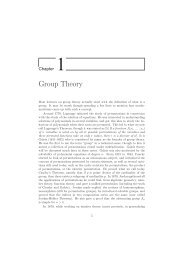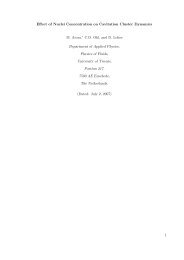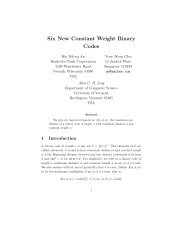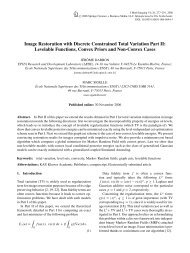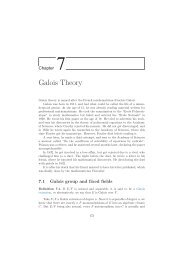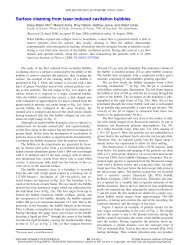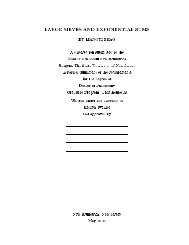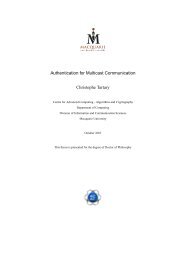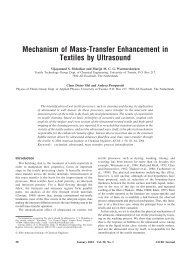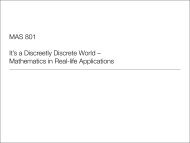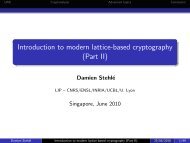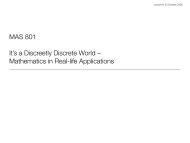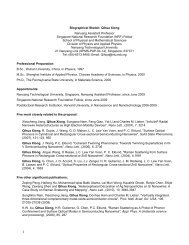Luminescence from Spherically and Aspherically Collapsing Laser ...
Luminescence from Spherically and Aspherically Collapsing Laser ...
Luminescence from Spherically and Aspherically Collapsing Laser ...
You also want an ePaper? Increase the reach of your titles
YUMPU automatically turns print PDFs into web optimized ePapers that Google loves.
VOLUME 80, NUMBER 2 PHYSICAL REVIEW LETTERS 12JANUARY 1998<br />
<strong>Luminescence</strong> <strong>from</strong> <strong>Spherically</strong> <strong>and</strong> <strong>Aspherically</strong> <strong>Collapsing</strong> <strong>Laser</strong> Induced Bubbles<br />
C. D. Ohl, O. Lindau, <strong>and</strong> W. Lauterborn<br />
Drittes Physikalisches Institut, Universität Göttingen, Bürgerstraße 42-44, D-37073 Göttingen, Federal Republic of Germany<br />
(Received 15 August 1997)<br />
Single cavitation bubble luminescence is investigated. The cavitation bubbles are produced by<br />
focused laser light <strong>and</strong> collapse under the action of the ambient pressure. Both spherical <strong>and</strong> aspherical<br />
collapse is studied. <strong>Luminescence</strong> is observed in both cases, but only up to a mildly aspherical collapse.<br />
[S0031-9007(97)04982-X]<br />
PACS numbers: 78.60.Mq, 47.55.Bx<br />
Light emission <strong>from</strong> bubbles in liquids has received<br />
increased attention with the advent of single bubble levitation<br />
in sound fields [1]. In this Letter we present<br />
investigations of the light emission <strong>from</strong> single collapsing<br />
cavitation bubbles: single cavitation bubble luminescence<br />
(SCBL). Our method makes use of focused laser light<br />
to produce largely empty bubbles in a liquid, a method<br />
used earlier for cavitation bubble dynamics studies [2,3].<br />
In contrast to acoustically driven bubbles in SBSL (single<br />
bubble sonoluminescence) [1] <strong>and</strong> MBSL (multibubble<br />
sonoluminescence) [4] experiments, laser induced bubbles<br />
do not need a sound field for a strong collapse <strong>and</strong> for<br />
light emission [5]. <strong>Laser</strong> induced bubbles can be made to<br />
collapse in adjustable aspherical geometry <strong>and</strong> thus may<br />
settle some questions about the origin of the luminescence.<br />
SCBL may also serve as a link between SBSL <strong>and</strong> MBSL<br />
in that the aspherical environment present in MBSL can be<br />
simulated in SCBL.<br />
Figure 1 shows a sketch of the experimental arrangement<br />
used to investigate the bubble dynamics <strong>and</strong> the<br />
light emission during bubble collapse. A Q-switched<br />
Nd:YAG laser delivers single laser pulses of 8 ns width<br />
<strong>and</strong> up to 20 mJ energy at a wavelength of 1064 nm.<br />
The laser light is focused with an aberration minimized<br />
lens system into a cuvette filled with bidistilled water<br />
(85 mm 3 85 mm 3 75 mm, water at room temperature<br />
<strong>and</strong> air saturated). A focus angle of 25 ± places<br />
the focus 27 mm <strong>from</strong> the cuvette wall. This allows a<br />
nearly spherical geometry in the surrounding liquid for<br />
the investigated bubble sizes ranging <strong>from</strong> 0.8 mm to<br />
1.5 mm in radius. Single bubbles are nucleated at the<br />
focus of the laser pulse when the dielectric breakdown<br />
threshold is reached, <strong>and</strong> a rapidly exp<strong>and</strong>ing plasma is<br />
formed. The recombining plasma gives rise to a gas<strong>and</strong><br />
vapor-filled bubble that grows to a maximum radius<br />
depending on the laser pulse parameters, in particular,<br />
pulse length <strong>and</strong> pulse energy [6]. The bubble collapses<br />
down to a minimum size until the compressed gas in<br />
the bubble leads to a rebound. During the collapse<br />
process, the bubble dissipates energy, mainly through<br />
emission of acoustic transients, <strong>and</strong> therefore reexp<strong>and</strong>s<br />
to a smaller, second maximum bubble radius. The bubble<br />
dynamics is resolved with an image converter camera at<br />
227.000 framess (Imacon 700, Hadl<strong>and</strong> Photonics) with<br />
eight separate frames read out via a CCD (charge-coupled<br />
device) camera (1317 3 1013 pixel, 12 bit, Quantix,<br />
Photometrics). Each pixel of the CCD covers 6.25 2 mm 2<br />
field of view.<br />
To suppress the intense continuum light emission of the<br />
dielectric breakdown process, a gateable camera system<br />
with a high contrast ratio between the shuttered <strong>and</strong> opened<br />
state is needed. An intensified CCD system (PicoStar,<br />
LaVision) with a gated multichannel plate (MCP) <strong>and</strong><br />
a gated photocathode serves this purpose. The gating<br />
times can be adjusted <strong>from</strong> 1 ms down to 120 ps. At<br />
the highest gain voltage of the MCP, one photoelectron<br />
is intensified to 150 counts. A fiber coupled slow scan<br />
CCD (384 3 286 pixel, 12 bit) integrates the light during<br />
the opening time. The optical imaging is done with a long<br />
distance microscope at 137 mm (73 mm in water, 5 mm<br />
cuvette glass thickness, <strong>and</strong> 59 mm in air) <strong>from</strong> the laser<br />
focus with 103 magnification, which gives 2.94 2 mm 2<br />
field of view for each CCD pixel. The diameter of the<br />
aperture of the long distance microscope is 42 mm. The<br />
illumination with a photo flash (60 ms duration) <strong>and</strong> a<br />
ground glass plate is used either for the imaging of the<br />
bubble with the converter camera or, with considerable<br />
attenuation, for the photography of the bubble shape with<br />
the ICCD (intensified CCD).<br />
The acoustic transients at bubble generation <strong>and</strong> at<br />
bubble collapse are recorded with a PVDF hydrophone<br />
having a b<strong>and</strong>width of 10 MHz (<strong>from</strong> CERAM AB,<br />
FIG. 1. Experimental arrangement for investigation of bubble<br />
dynamics <strong>and</strong> the emission of light of a laser induced cavitation<br />
bubble during collapse.<br />
0031-90079880(2)393(4)$15.00 © 1998 The American Physical Society 393
VOLUME 80, NUMBER 2 PHYSICAL REVIEW LETTERS 12JANUARY 1998<br />
Sweden) <strong>and</strong> are stored on a transient recorder (TDS<br />
784A, Tektronix) together with the monitor output of the<br />
image converter camera <strong>and</strong> the ICCD gate. The trigger<br />
for the individual devices are generated with a separate<br />
timing computer <strong>and</strong> a four-channel delay generator.<br />
For the investigation of aspherical bubble collapse, a<br />
height adjustable rigid boundary of perspex is placed<br />
below the laser focus.<br />
The technique for generation of cavitation through a<br />
laser induced dielectric breakdown allows the creation of a<br />
bubble in a highly reproducible way [2,3]. In the absence<br />
of a boundary, the bubble collapses spherically <strong>and</strong> emits<br />
a single shock wave [3]. Its dynamics can be very well<br />
modeled until the late stage of collapse with Gilmore’s<br />
model [7].<br />
Figure 2 shows an image of the luminescence which occurs<br />
during the spherical bubble collapse taken with the<br />
ICCD camera. The gating time was adjusted to 5 ms <strong>and</strong><br />
an attenuated flash illuminates the bubble outline. The<br />
bright SCBL spot in Fig. 2 is centered. Light emission<br />
is only observed if the gating time of the ICCD covers<br />
the bubble collapse, which has been checked with the<br />
recorded hydrophone signal. Further, no measurable photon<br />
counts of the broad <strong>and</strong> intense continuum emission<br />
emitted <strong>from</strong> the dielectric breakdown are accumulated<br />
on the ICCD chip. This is a prerequisite for studying<br />
the spherical bubble collapse because the dielectric breakdown<br />
occurs at the same spatial position as the collapse<br />
<strong>and</strong> could lead to false interpretation. The maximum radius<br />
of the bubble, R max , in Fig. 2 was determined through<br />
Rayleigh’s formula [8], Eq. (1), <strong>from</strong> the duration between<br />
bubble generation <strong>and</strong> bubble collapse 2T c 150.4 ms to<br />
R max 0.813 mm:<br />
R max <br />
µ r<br />
0.915<br />
r<br />
p 2 p d<br />
∂ 21<br />
T c , (1)<br />
where r 998.2 kgm 3 is the density of the liquid, p <br />
1 bar is the ambient pressure, <strong>and</strong> p d 0.0233 bar is the<br />
vapor pressure at T 20 ± C.<br />
The lower bound for the number of photons emitted can<br />
be roughly approximated: A single image of the luminescence<br />
with the same bubble size but without illumination<br />
gives 3.4 3 10 5 counts; a single photoelectron gives<br />
64 counts at the adjusted voltage of the MCP. The quantum<br />
efficiency for the photocathode at 400 nm is 0.03.<br />
This efficiency is approximately valid for the luminescence,<br />
as has been checked with different cut-off filters.<br />
Further, the light is assumed to be emitted uniformly into<br />
the solid angle of 4p, <strong>and</strong>, with an ideal optics without<br />
reflection losses, the long distance microscope images<br />
1170th of the photons <strong>from</strong> geometrical considerations.<br />
In this way, a lower bound of emitted photons during<br />
primary bubble collapse is determined to 30 3 10 6 photons<br />
for R max 0.813 mm. In Fig. 3 the lower bound<br />
for the number of photons emitted for different maximum<br />
bubble sizes is plotted as dark squares. For each data point,<br />
ten luminescence events have been summed up onto the<br />
CCD chip <strong>and</strong> averaged. The dark signal has been subtracted<br />
<strong>from</strong> the images, <strong>and</strong> the number of photons have<br />
been estimated as above. A linear regression (dashed line<br />
in Fig. 3) gives a slope of 57 3 10 6 photons per mm maximum<br />
radius. There exists a threshold for the dielectric<br />
breakdown [6] whereby a bubble with a certain content of<br />
gas <strong>and</strong> vapor <strong>and</strong> a certain initial bubble wall velocity is<br />
formed. The resulting smallest R max formed at the dielectric<br />
breakdown threshold (90% likelihood) was very close<br />
to 0.7 mm.<br />
The ICCD camera takes a picture of the bubble illuminated<br />
by the light scattered <strong>from</strong> its interior. Assuming<br />
the luminescence event to be short, it freezes the bubble<br />
wall motion: A stop motion picture of the bubble at luminescence<br />
is photographed. From the diameter of the luminescence<br />
spot, an example of which is given in Fig. 2, we<br />
FIG. 2. ICCD image with a 5 ms shutter open time of a luminescing<br />
cavitation bubble with weak additional illumination<br />
<strong>from</strong> the front. The bubble appears dark on a bright background<br />
with the luminescence spot in the middle. During the<br />
shutter open time, the bubble wall collapses <strong>from</strong> the position<br />
marked with the dashed outline to a smaller bubble size, <strong>and</strong><br />
therefore its shape becomes blurred. The size of the frame is<br />
0.784 mm 3 0.784 mm.<br />
FIG. 3. Lower bound for the number of photons emitted<br />
during the primary bubble collapse for different maximum<br />
bubble radii.<br />
394
VOLUME 80, NUMBER 2 PHYSICAL REVIEW LETTERS 12JANUARY 1998<br />
can conclude that a bubble has a radius of 15 6 6 mm for<br />
R max 0.813 mm when luminescence occurs.<br />
When the fluid flow in the surroundings of a bubble is<br />
disturbed, e.g., by a rigid boundary, the bubble dynamics<br />
before collapse is altered in a complex way. A simple<br />
description of the dynamics is given in the following:<br />
The bubble reduces its size, but the bubble wall nearer<br />
to the boundary is less strongly accelerated (as its flow is<br />
hindered by the boundary) than the radial flow <strong>from</strong> above.<br />
An indentation at the opposite bubble wall is formed <strong>and</strong><br />
gives rise to an additional flow, apart <strong>from</strong> the pure radial<br />
one, in a direction towards the boundary. From momentum<br />
conservation [9], the bubble center accelerates during the<br />
collapse <strong>and</strong> moves towards the boundary. Considering a<br />
mirror bubble to fulfill the velocity boundary conditions<br />
on the rigid boundary, the attraction can be ascribed to<br />
the secondary Bjerknes force [10]. After the collapse, the<br />
bubble reexp<strong>and</strong>s with a liquid flow, the jet, in a direction<br />
towards the boundary, forming a protrusion of the bubble<br />
which, for example, is visible in Fig. 4 (frames 4–7).<br />
The dimensionless parameter g sR max helps to characterize<br />
the bubble collapse for different bubble radii R max<br />
<strong>and</strong> distances s of the bubble center <strong>from</strong> the boundary.<br />
Varying the parameter g <strong>from</strong> `, which is the spherical<br />
case, to a smaller value increases the influence of the<br />
boundary <strong>and</strong> thus the asphericity of the bubble collapse.<br />
Figure 4 consists of a combination of the two shared photographic<br />
devices. The frames 1–7 show the bubble dynamics<br />
for g 5.9. The bubble prior to collapse, frames<br />
1 <strong>and</strong> 2, has a spherical shape. The bubble reaches minimum<br />
volume between frames 3 <strong>and</strong> 4, <strong>and</strong> the bubble center<br />
moves towards the boundary. The protrusion at the<br />
lower bubble wall is formed on a slower time scale than<br />
the bubble collapse, which is not resolved in greater de-<br />
FIG. 4. Frames 1–7: bubble dynamics <strong>and</strong> light emission near<br />
a rigid boundary (not visible) placed s 4.9 mm below the<br />
laser focus photographed with the image converter camera.<br />
The bubble reaches a maximum radius of R max 0.83 mm,<br />
leading to g 5.9. The frames have 4.4 ms interframe time.<br />
Frame 3a: Blended picture of frame 3 <strong>and</strong> photograph of the<br />
light emission with the ICCD for a bubble with the same<br />
experimental parameters. The size of all individual frames is<br />
1.56 mm 3 1.25 mm.<br />
tail. The liquid jet pushes the protrusion, whereas the main<br />
bubble body gains nearly spherical shape again.<br />
Frame 3a of Fig. 4 is a blended image of the ICCD picture<br />
<strong>and</strong> frame 3. The cavitation luminescence is visible<br />
as the bright spot at the center of the lower bubble wall.<br />
The two imaging devices have photographed a different<br />
bubble, but the experimental parameters have not been altered.<br />
The high reproducibility of the experiment has been<br />
checked with the image converter camera, comparing the<br />
bubble dynamics for similar hydrophone signals <strong>and</strong> an unaltered<br />
boundary position. This is a precaution needed to<br />
compare the image of the ICCD <strong>and</strong> the images of the converter<br />
camera. Blending of the two frames has been controlled<br />
in two ways: First, the position of the light emission<br />
of the spherical bubble collapse was taken to determine the<br />
displacement of the luminescence in the aspherical case.<br />
With the displacement <strong>and</strong> the center of the bubble in frame<br />
one <strong>and</strong> the correct scaling of the ICCD image both images<br />
can be blended as done in frame 3a of Fig. 4. The blending<br />
was controlled to be correct with a second method. The<br />
attenuated flash, similar to that used in Fig. 2, illuminates<br />
the bubble shape. Thus, moving the ICCD image over the<br />
frames 5 to 7 of the image converter camera for the best<br />
visual match of the bubble shapes leads to the same displacement.<br />
The weak bright shades in frame 3a are due to<br />
the flash illumination of the bubble shape.<br />
With this blending technique, we find that the light<br />
emission is located 103 mm below the laser focus. The<br />
light emission occurs at the very late stage of bubble<br />
collapse <strong>and</strong> is a single event. If multiple emission events<br />
would occur, a line or several discrete bright spots would<br />
have been imaged as the movement of the collapsing<br />
bubble would separate them spatially.<br />
Calculation of the number of photons in the same way as<br />
in the spherical case gives 1.7 3 10 6 photons for g 5.9<br />
<strong>and</strong> 5 3 10 5 photons for g 4.7. It is shown that the<br />
integrated luminescence decreases with smaller g values,<br />
<strong>and</strong> no light emission <strong>from</strong> the bubble has been observed<br />
for g below about 3.5. Thus we can state that cavitation<br />
luminescence needs a highly spherical bubble collapse.<br />
<strong>Luminescence</strong> has been observed for all cavitation bubbles<br />
collapsing in spherical geometry. No luminescence<br />
has been observed during the second bubble collapse. The<br />
bubble rebounds after the first collapse to a smaller maximum<br />
radius due to the energy loss, mainly <strong>from</strong> emission<br />
of the shock wave. Thus the second collapse obviously is<br />
not strong enough to fulfill the conditions for light emission.<br />
The emission occurs at the geometrical center of the<br />
bubble <strong>and</strong>, as stated above, we assume that the shape of<br />
the emission is an image of the bubble scattering the light<br />
<strong>from</strong> its interior.<br />
The photon numbers per luminescence event are at least<br />
an order of magnitude greater than observed in SBSL<br />
experiments. This is as expected, because the maximum<br />
bubble sizes for laser induced bubbles are 10 to 30 times<br />
larger compared to an SBSL experiment. Fitting measured<br />
395
VOLUME 80, NUMBER 2 PHYSICAL REVIEW LETTERS 12JANUARY 1998<br />
radius-time curves up to the second bubble collapse gives<br />
an approximate equilibrium bubble radius R 0 (bubble<br />
radius under static conditions). For the investigated maximum<br />
bubble radii the ratio R max R 0 lies in the range<br />
between 5–10.<br />
Jet theories [11] also rely on a nearly spherical collapse<br />
as then the jet velocities are higher when the jet forms.<br />
However, they are invalid for a perfectly spherical collapse,<br />
i.e., in the limit where asphericity turns to sphericity<br />
[12]. <strong>Aspherically</strong> collapsing bubbles luminesce at the<br />
bubble site of jet impact. This feature they share with<br />
shock compressed cylindrical bubbles in gels [13]. Time<br />
resolution in this experiment does not yet allow us to distinguish<br />
whether it is the instant of jet impact or the instant of<br />
bubble minimum when the luminescence flash is emitted.<br />
Even a framing rate of 20 3 10 6 framess [3] would not<br />
be high enough for g larger than 3.5. For these cases, due<br />
to the increased sphericity, jet impact <strong>and</strong> bubble minimum<br />
are separated by less than 50 ns, the framing resolution of<br />
the camera.<br />
<strong>Laser</strong> induced cavitation bubbles may become an intrinsic<br />
tool for further studies of luminescence accompanying<br />
bubble collapse. The very small size of SBSL bubbles<br />
at the moment of luminescence can be overcome with<br />
laser induced bubbles in SCBL. Another advantage is that<br />
no sound field is necessary as the bubble is fed with energy<br />
through the exp<strong>and</strong>ing plasma at dielectric breakdown.<br />
Therefore, experiments with laser induced bubbles<br />
do not have to cope with diffusion stability [14] <strong>and</strong> with<br />
the Bjerknes force threshold [15]. Moreover, systematic<br />
studies of luminescence <strong>from</strong> aspherical bubble collapse<br />
now open up a way to elucidate the mysterious connection<br />
between SBSL <strong>and</strong> MBSL [16]. Pictures of aspherically<br />
oscillating bubbles, but without luminescence, can be<br />
found in a recent publication [17]. SCBL can also be exp<strong>and</strong>ed<br />
to MCBL (multicavitation bubble luminescence).<br />
Two luminescence spots have been observed <strong>from</strong> two<br />
nearby cavitation bubbles, for instance.<br />
This work has been supported by the Fraunhofer Gesellschaft.<br />
We thank the company, LaVision, Göttingen,<br />
for the loan of the ICCD camera, <strong>and</strong> the friendly support<br />
<strong>from</strong> Dr. Ahuja. We are especially grateful for the<br />
inspiring discussions with the members of the Cavitation<br />
<strong>and</strong> Sonoluminescence Group at the Drittes Physikalisches<br />
Institut, Göttingen.<br />
[1] B. P. Barber, R. A. Hiller, R. Löfstedt, S. J. Putterman, <strong>and</strong><br />
K. R. Weninger, Phys. Rep. 281, 65 (1997); L. A. Crum<br />
<strong>and</strong> T. J. Matula, Science 276, 1348 (1997).<br />
[2] W. Lauterborn, Acustica 31, 51 (1974); A. Vogel,<br />
W. Lauterborn, <strong>and</strong> R. Timm, J. Fluid Mech. 206, 299<br />
(1989); B. Ward <strong>and</strong> D. C. Emmony, J. Acoust. Soc. Am.<br />
88, 434 (1990); Y. Tomita <strong>and</strong> A. Shima, Acustica 71,<br />
161 (1990); A. Philipp <strong>and</strong> W. Lauterborn, Acustica 83,<br />
223 (1997).<br />
[3] C. D. Ohl, A. Philipp, <strong>and</strong> W. Lauterborn, Ann. Phys.<br />
(Leipzig) 4, 26 (1995).<br />
[4] H. Kuttruff, Acustica 11, 230 (1962); A. J. Walton <strong>and</strong><br />
G. T. Reynolds, Adv. Phys. 33, 595 (1984).<br />
[5] A. A. Buzukov <strong>and</strong> V. S. Teslenko, JETP Lett. 14,<br />
189 (1971); A. G. Akmanov, V. G. Ben′kovskii, P. I.<br />
Golubnichii, S. I. Maslennikov, <strong>and</strong> V. G. Shemanin, Sov.<br />
Phys. Acoust. 19, 417 (1974).<br />
[6] C. A. Sacchi, J. Opt. Soc. Am. B 8, 337 (1991); A. Vogel,<br />
S. Busch, <strong>and</strong> U. Parlitz, J. Acoust. Soc. Am. 100, 148<br />
(1996).<br />
[7] F. R. Gilmore, “The Growth or Collapse of a Spherical<br />
Bubble in a Viscous Compressible Liquid,” Hydrodynamics<br />
Laboratory, California Institute of Technology,<br />
Pasadena, California, Report No. 26-4, 1952.<br />
[8] J. Rayleigh, Philos. Mag. 34, 94 (1917).<br />
[9] T. B. Benjamin <strong>and</strong> A. T. Ellis, Philos. Trans. R. Soc.<br />
London A 260, 221 (1966).<br />
[10] V. F. K. Bjerknes, Fields of Force (Columbia University<br />
Press, New York, 1906); T. G. Leighton, The Acoustic<br />
Bubble (Academic, London, 1994).<br />
[11] A. Prosperetti, J. Acoust. Soc. Am. 101, 2003 (1997);<br />
T. Lepoint, D. De Pauw, F. Lepoint-Mullie, M. Goldman,<br />
<strong>and</strong> A. Goldman, J. Acoust. Soc. Am. 101, 2012<br />
(1997).<br />
[12] A look into the interior of a collapsing bubble to clarify<br />
whether a jet has formed or the sphericity has remained is<br />
still beyond the experimental state of the art.<br />
[13] N. K. Bourne <strong>and</strong> J. E. Field, J. Fluid Mech. 244, 225<br />
(1992).<br />
[14] S. Hilgenfeldt, D. Lohse, <strong>and</strong> M. P. Brenner, Phys. Fluids<br />
8, 2808 (1996); I. Akhatov, N. Gumerov, C. D. Ohl,<br />
U. Parlitz, <strong>and</strong> W. Lauterborn, Phys. Rev. Lett. 78, 227<br />
(1997).<br />
[15] I. Akhatov, R. Mettin, C. D. Ohl, U. Parlitz, <strong>and</strong><br />
W. Lauterborn, Phys. Rev. E 55, 3747 (1997).<br />
[16] L. A. Crum, J. Acoust. Soc. Am. 95, 559 (1994); T. J.<br />
Matula, R. A. Roy, P. D. Mourad, W. B. McNamara III,<br />
<strong>and</strong> K. S. Suslick, Phys. Rev. Lett. 75, 2602 (1995); T. J.<br />
Matula, R. A. Roy, <strong>and</strong> P. D. Mourad, J. Acoust. Soc. Am.<br />
101, 1994 (1997).<br />
[17] Y. Tian, J. A. Ketterling, <strong>and</strong> R. E. Apfel, J. Acoust. Soc.<br />
Am. 100, 3976 (1997).<br />
396



